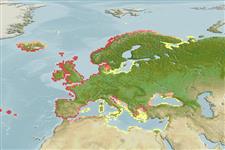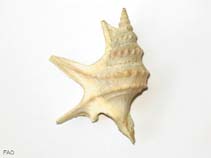Aporrhais pespelecani (Linnaeus, 1758)
Pelican's foot| Native range | All suitable habitat | Point map | Year 2050 |

|
| This map was computer-generated and has not yet been reviewed. |
| Aporrhais pespelecani AquaMaps Data sources: GBIF OBIS |
Classification / Names Common names | Synonyms | CoL | ITIS | WoRMS
| Littorinimorpha | Aporrhaidae
Environment: milieu / climate zone / depth range / distribution range يسانش موب
; قمع تارييغت 6 - 8 m (Ref. 118694). Temperate; 76°N - 25°N, 31°W - 61°E
شنكارپ اهروشك | )OAF( يناهج راب و راوخ نامزاس قطانم | Ecosystems | روهظ | يفرعم
Northeast Atlantic, Arctic and the Mediterranean: North and Celtic seas. Temperate to polar.
Length at first maturity / Size / Weight / نس
Maturity: Lm ? range ? - ? cmCommon length : 5.1 cm SHL يسنج صاوخ نودب / رن سنج; (Ref. 360)
رصتخم فيصوت يسانش تخير
Shell: quite high conical spire, with an outer lip characteristically broadened and fingered, looking like a bird's foot; whorls are angular with a nodular median keel (two in the body whorl); the suture is hardly incised; outer lip of the aperture is thickened, and the inner lip produces a marked columellar callus; development of the external fingers marks the attainment of maturity; sculpture consists of the nodular keel and thin spiral grooves that extend over the whole surface; coloration is variable, white, beige, darkish chestnut, reddish brown or patched, axially flamed with draker shades than the base color; operculum is horny, ellipsoidal and with a terminal nucleus. Body: pink or reddish with whitish spots, foot is very long and narrow; eyes sessile, set at the bases of the long tentacles; mantle cavity has one gill, the osphradium/penis; radula is taenioglossan.
This is a carnivorous species (Ref. 96498).
Life cycle and mating behavior غولب | لثم دیلوت | یزیر مخت | اه مخت | Fecundity | )ورال ( دازوت
Members of the order Neotaenioglossa are mostly gonochoric and broadcast spawners. Life cycle: Embryos develop into planktonic trocophore larvae and later into juvenile veligers before becoming fully grown adults.
یلصا ذخآم
عجارم | هدننك گنهامه | ناراكمه
Sabelli, B. and H.S. Feinberg (eds.). 1879. (Ref. 360)
NCUI زمرق تسرهف رد تيعضو (Ref. 130435)
ستياس رظن زا تيعضو (Ref. 108899)
Not Evaluated
CMS (Ref. 116361)
Not Evaluated
اه ناسنا یارب رطخ
یناسنا هدافتسا
| FishSource |
اهرازبا
رتشيب تاعالطا
يتنرتنيا عبانم
Alien/Invasive Species database | BHL | BOLD Systems | CISTI | DiscoverLife | FAO(Publication : search) | Fishipedia | GenBank (مونژ, ديتوئلکون) | GloBI | Gomexsi | Google Books | Google Scholar | Google | PubMed | Tree of Life | Wikipedia (ورب, وجتسج) | Zoological Record
Estimates based on models
تميق هقبط
(Ref. 80766):
Unknown.



